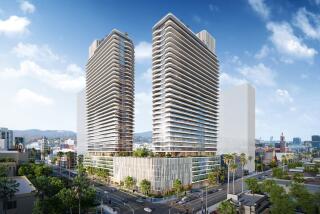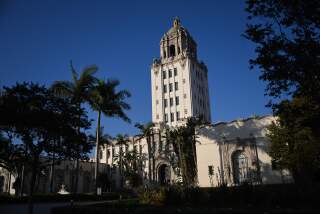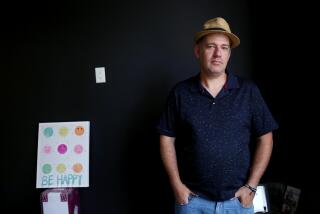Kushner tapped program meant for job-starved areas to build a luxury skyscraper
- Share via
Jared Kushner and his real estate partners wanted to take advantage of a federal program in 2015 that would save them millions of dollars as they built an opulent, 50-story residential tower in Jersey City, N.J.’s booming waterfront district, just across the Hudson River from Lower Manhattan.
There was just one problem: The program was designed to benefit projects in poor, job-starved areas.
So the project’s consultants got creative, records show.
They worked with state officials in New Jersey to come up with a map that defined the area around 65 Bay Street as a swath of land that stretched nearly four miles and included some of the city’s poorest and most crime-ridden neighborhoods. At the same time, they excluded some wealthy neighborhoods only blocks away.
The tactic — critics liken it to the gerrymandering of legislative districts — made it appear that the site was in an area with extraordinarily high unemployment, allowing Kushner Cos. and its partners to get $50 million in low-cost financing through the EB-5 visa program.
The move was legal, and other developers have used similar strategies in recent years, often aided by state officials who welcome the infusion of cash. But it illustrates how Kushner — who ran his family’s real estate company before he became a senior advisor to President Trump — and his partners exploited a loophole in a federal program that prominent members of both parties say has been plagued by fraud and abuse.
On the south side of Jersey City, which has some of the most entrenched poverty in the New York City region, many people interviewed one day last week were surprised that their neighborhood’s troubles were part of the reason that 65 Bay Street got cheap financing.
“That’s very sad,” said Pastor Shyrone Richardson of the World Outreach Christian Church in the struggling Bergen-Lafayette section of Jersey City. “Unfortunately, the people who are benefiting from this are not the people in this area.”
Richardson’s church is in a five-block area where nearly one in five were jobless and there were three fatal shootings in 2015, according to an analysis of crime and census data.
His neighborhood seems a world away from the gleaming office towers and trendy cafes that surround 65 Bay Street. The Jersey City waterfront saw a building boom after 9/11 that transformed the area into one of the hottest real estate markets in the New York metro region, drawing residents from Manhattan and Brooklyn.
Apartments in the Bay Street building, marketed as Trump Bay Street, rent for up to $4,700 a month and offer sweeping views of Lower Manhattan. A nearby commuter train shuttles passengers to the World Trade Center within minutes. The area within a roughly three-block radius around the building had an unemployment rate of just 2.6% in 2015, according to census data.
Under the EB-5 program, a wealthy foreigner can get a fast-track visa granting U.S. residency by investing at least $500,000 in a project in a “targeted employment area.” To qualify, the area must have an unemployment rate at least 1½ times the national average. For developers, the terms of the investment are more favorable than a bank loan.
The Trump administration is considering whether to adopt changes that would prevent EB-5 gerrymandering. Kushner has said he will recuse himself from any discussions on the program.
Kushner Cos., meanwhile, is rushing to raise $150 million in low-cost financing through EB-5 for a separate project in Jersey City: a pair of luxury towers in an area called Journal Square. Kushner’s sister caused a stir this month when she mentioned her brother in a pitch for the project to investors in China.
For that project, too, the company is linking the development to blighted neighborhoods miles to the south while excluding adjoining neighborhoods that have lower unemployment rates, records show.
An executive at U.S. Immigration Fund-NJ, a firm helping Kushner Cos. raise EB-5 money for both projects, defended the practice. Mark Giresi, chief operating officer, called it a “common sense” approach that reflects the broader economic reality of each project’s surroundings. He also said jobs created by the project could be filled by workers from the depressed areas only miles away.
“In large urban markets like Jersey City these types of real estate development projects create much-needed jobs, particularly in the construction industry across areas of the city that cover multiple census tracts,” Giresi said in a statement. Census tracts are government-defined neighborhoods, sometimes as small as a few blocks.
Giresi said the Bay Street project created more than 1,280 construction and other jobs and that 1 Journal Square is projected to create 6,600. Under the program, each $500,000 investment must create at least 10 jobs.
The program’s critics say that cobbling together multiple census tracts to push up the average unemployment rate too often benefits developers and areas that do not need the government help. They point to EB-5 projects in prosperous areas of Manhattan, downtown Washington and in Beverly Hills.
“Many of these affluent-area projects would have been built and jobs created without the infusion of EB-5 capital,” said Gary Friedland, a scholar in residence at New York University’s Stern School of Business. “Consequently, deserving projects can’t be built and the resulting jobs are lost because the projects are deprived of the essential capital to proceed.”
The government caps the number of EB-5 visas it issues each year, and most of the resulting investment goes to high-profile projects in prosperous areas.
A spokeswoman for Kushner Cos. declined to comment, as did Jared Kushner’s spokesman.
Jared Kushner has sold his interest in 1 Journal Square but maintains an ownership stake in 65 Bay Street. The KABR Group, a partner in the luxury tower on Bay Street, also declined to comment.
Kushner’s prominence is drawing renewed attention to the practice, which has been the subject of years of debate in Congress and furious lobbying by the real estate industry. In interviews along Martin Luther King Drive in Jersey City last week, there was a common reaction.
“It’s like we’re being used,” said Helen Gathers, a registered nurse who has lived in Jersey City for 38 years.
Down the block, Laville Penn, a 54-year-old who was released from prison in early 2016 after a drug possession conviction, was looking for employment. He had been searching for steady work in construction for more than six months, he said, but had found only temporary day jobs.
Now, hoping to pick up some hours, he stopped by a lot where a friend was doing contract demolition work. Penn said the high-rises built in Jersey City are typically union jobs. “It’s difficult to get into the union if you don’t have certification or experience,” he said.
The EB-5 program was initiated in 1990 to help attract foreign investment to rural and poor, urban areas that have trouble drawing conventional financing or investment.
But developers are free to string together an endless number of contiguous census tracts until they reach the unemployment threshold. In the years since the Great Recession, this has often meant finding the nearest poor area and drawing a line to it.
Documents obtained from New Jersey through a public records request show just how easy that was for Kushner Cos. and KABR Group as they sought to build the Bay Street tower.
On May 6, 2015, Michael Evans, a consultant working on behalf of the project, sent an email to an official in the New Jersey Department of Labor asking that the Bay Street area be deemed an area with high unemployment. Individual states are responsible for reviewing unemployment data and issuing letters certifying that projects qualify for the federal program.
Evans wrote that such an area could be created by combining 26 census tracts in Jersey City that stretch more than two miles to the northwest and three miles to the southwest.
“The client as always is in a great hurry so if you can e-mail me the letter as soon as it is finished it would be appreciated,” Evans wrote. Evans did not respond to a request for comment.
There was a problem, though. The census tracts weren’t contiguous — and didn’t include the the project itself.
Three weeks later, the state, wrote back that the project qualified under a different but similarly attenuated configuration that achieved the same goal. New Jersey’s state website says it will help developers “perform a special tabulation for the area” of their project using census data.
The state-approved map strung together 16 census tracts that went nearly four miles to the southwest, crossing the New Jersey Turnpike and heading south to the Bergen-Lafayette and Greenville areas. Together, those neighborhoods had an average unemployment rate that edged just higher than 9.3%, the qualifying rate at the time.
That probably saved Kushner and his partners millions of dollars.
Developers typically pay only 4% to 8% interest annually on money raised through EB-5, experts said. Conventional financing can carry an interest rates of between 12% and 18%. On the $50 million for Bay Street, that difference amounts to millions of dollars annually over the life of the loan.
On Jan. 5 of this year, a little over two weeks before Trump was to take office, another consultant working on behalf of Kushner Cos. got in touch with New Jersey state officials again. This time, it was about 1 Journal Square. The census tract where it is located had an unemployment rate of 2.9% in 2015, but the consultant suggested adding five neighborhoods to triple that unemployment rate.
The approval came four days later, records show. Kushner’s sister went to China in May seeking the $150 million in EB-5 financing.
The Trump administration will decide in the coming months whether to enact rules, proposed by the Obama administration, limiting the census tracts that can be considered for EB-5 eligibility to only those directly adjacent to the tract containing the development.
The proposal is being considered by Secretary of Homeland Security John Kelly. Under the proposed rules, neither the 65 Bay Street tower nor the proposed 1 Journal Square project would be in a “targeted employment area.”
Boburg writes for the Washington Post.
More to Read
Inside the business of entertainment
The Wide Shot brings you news, analysis and insights on everything from streaming wars to production — and what it all means for the future.
You may occasionally receive promotional content from the Los Angeles Times.










